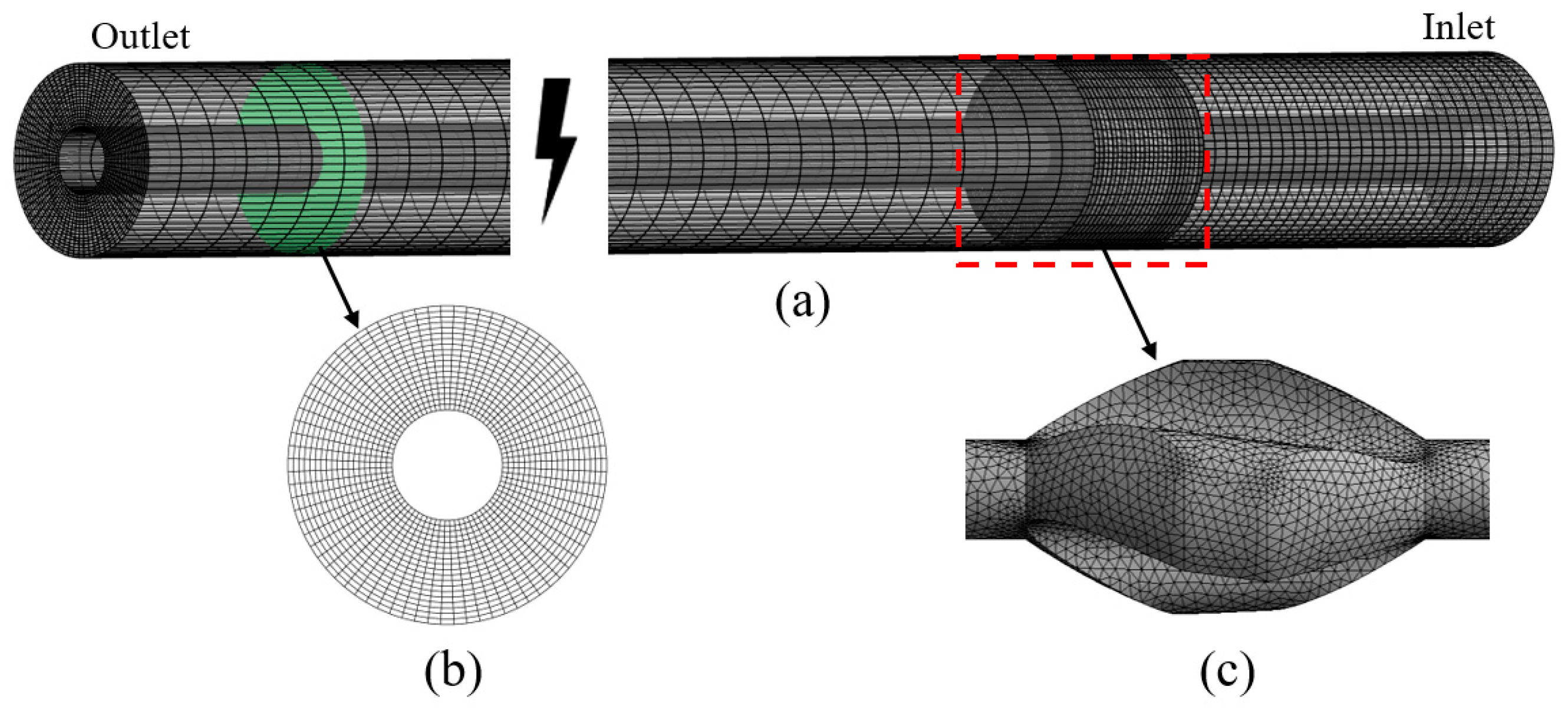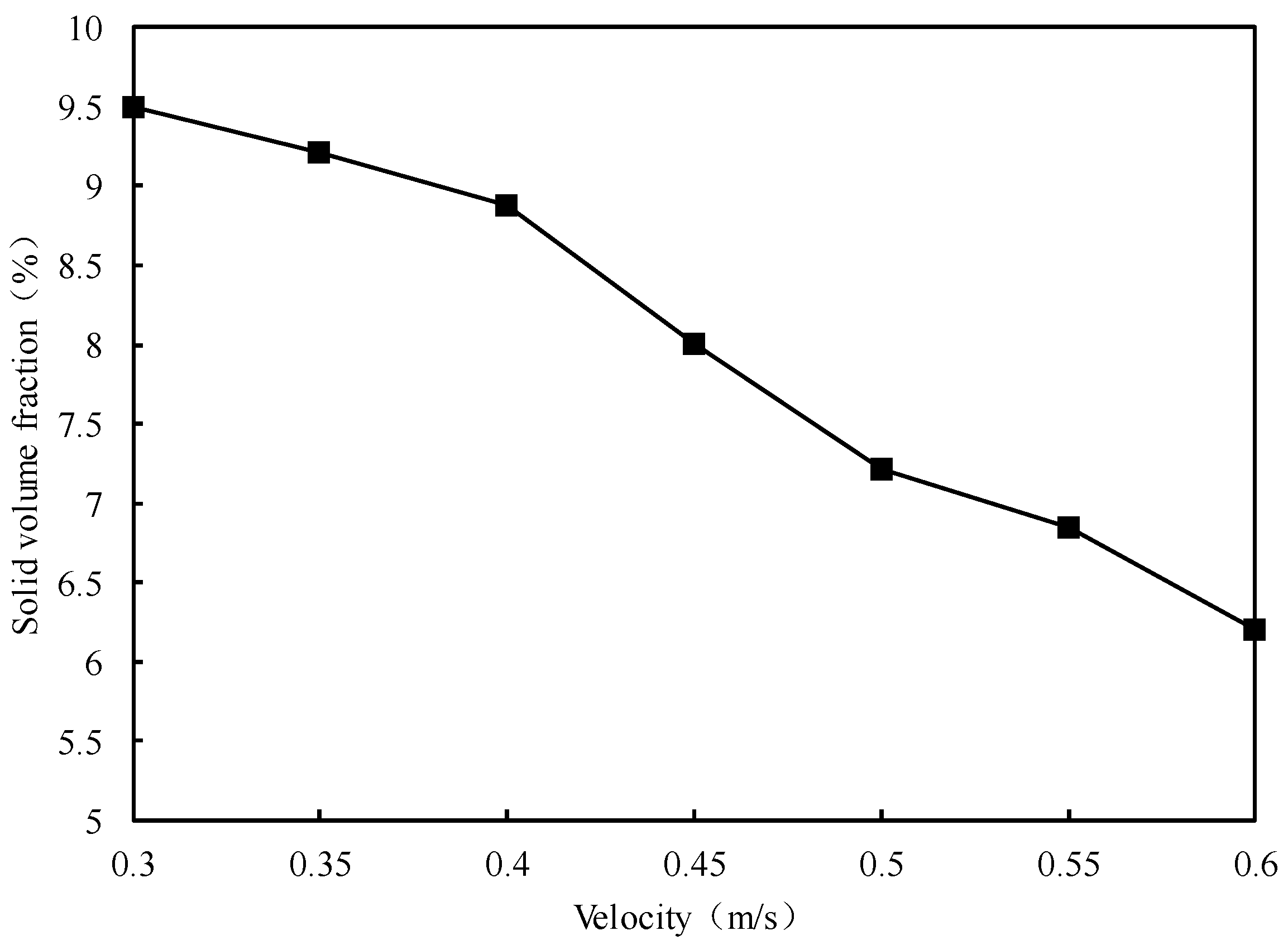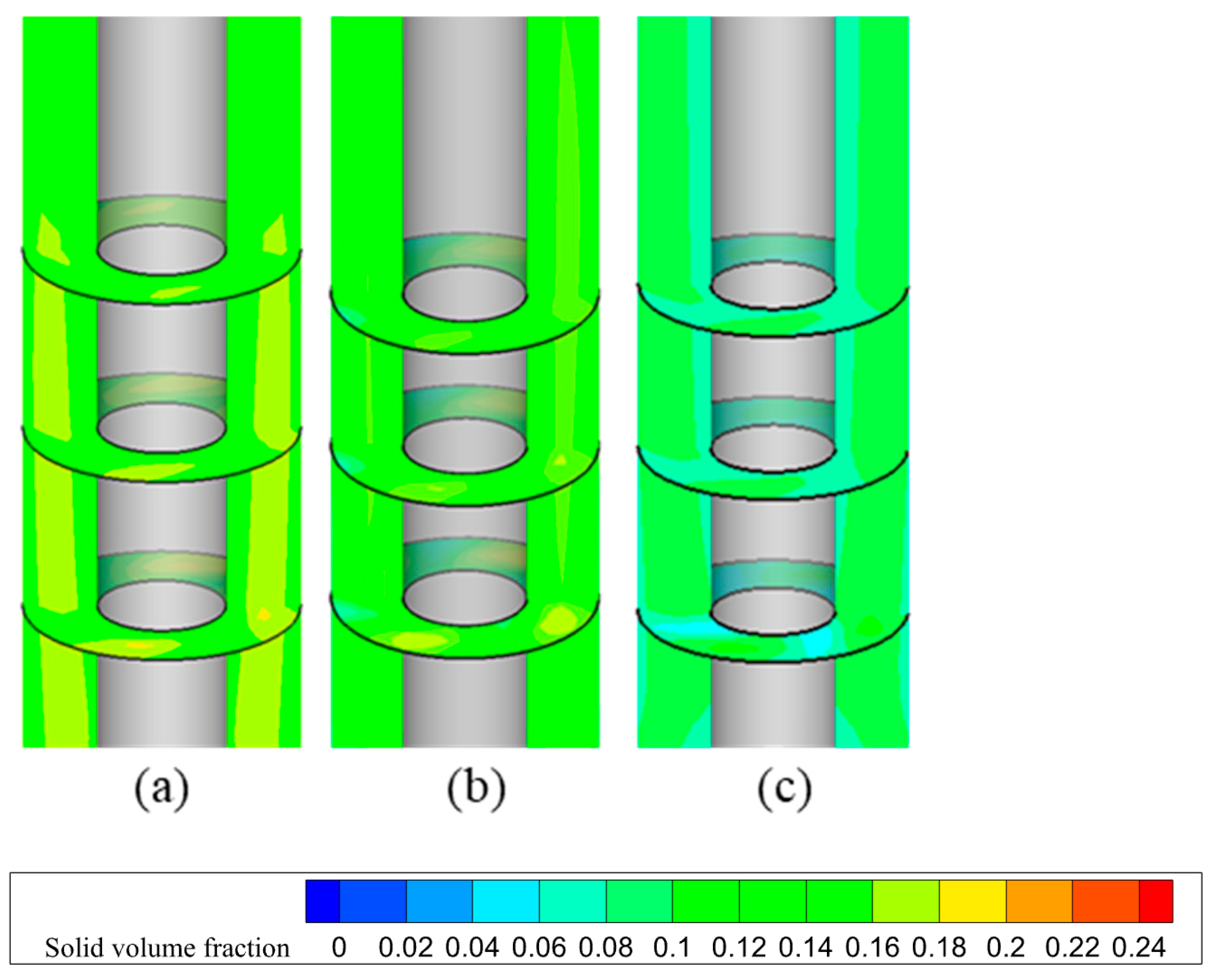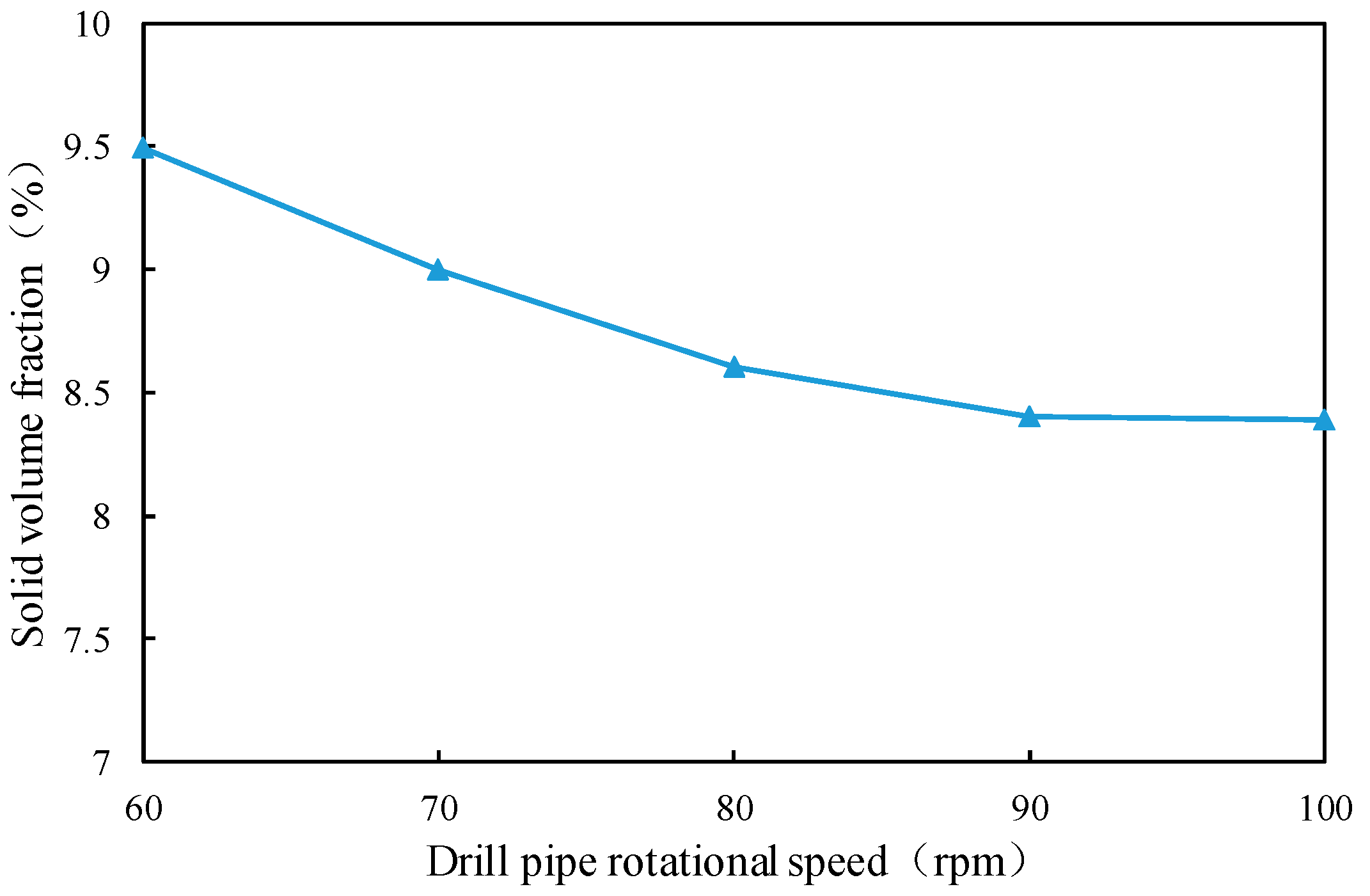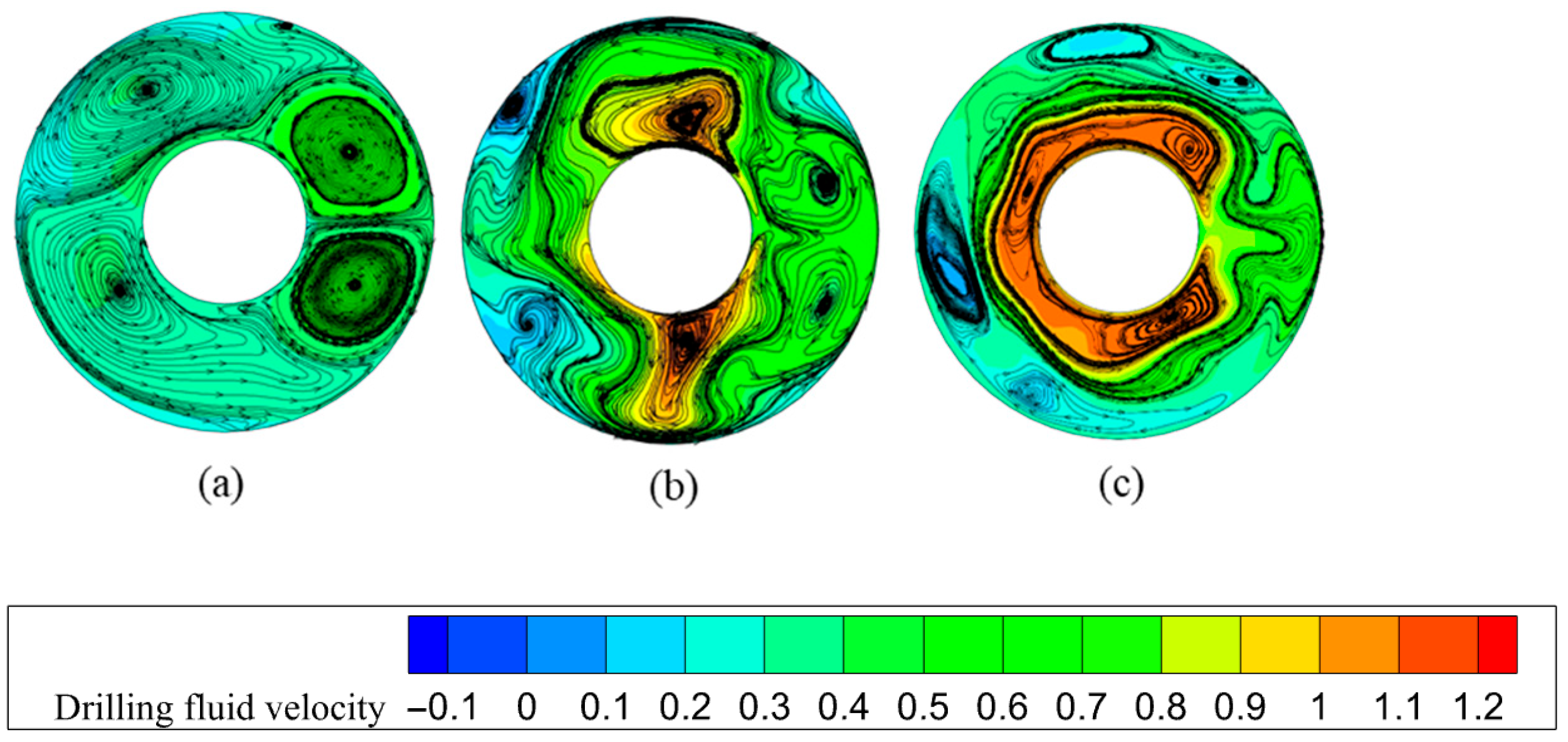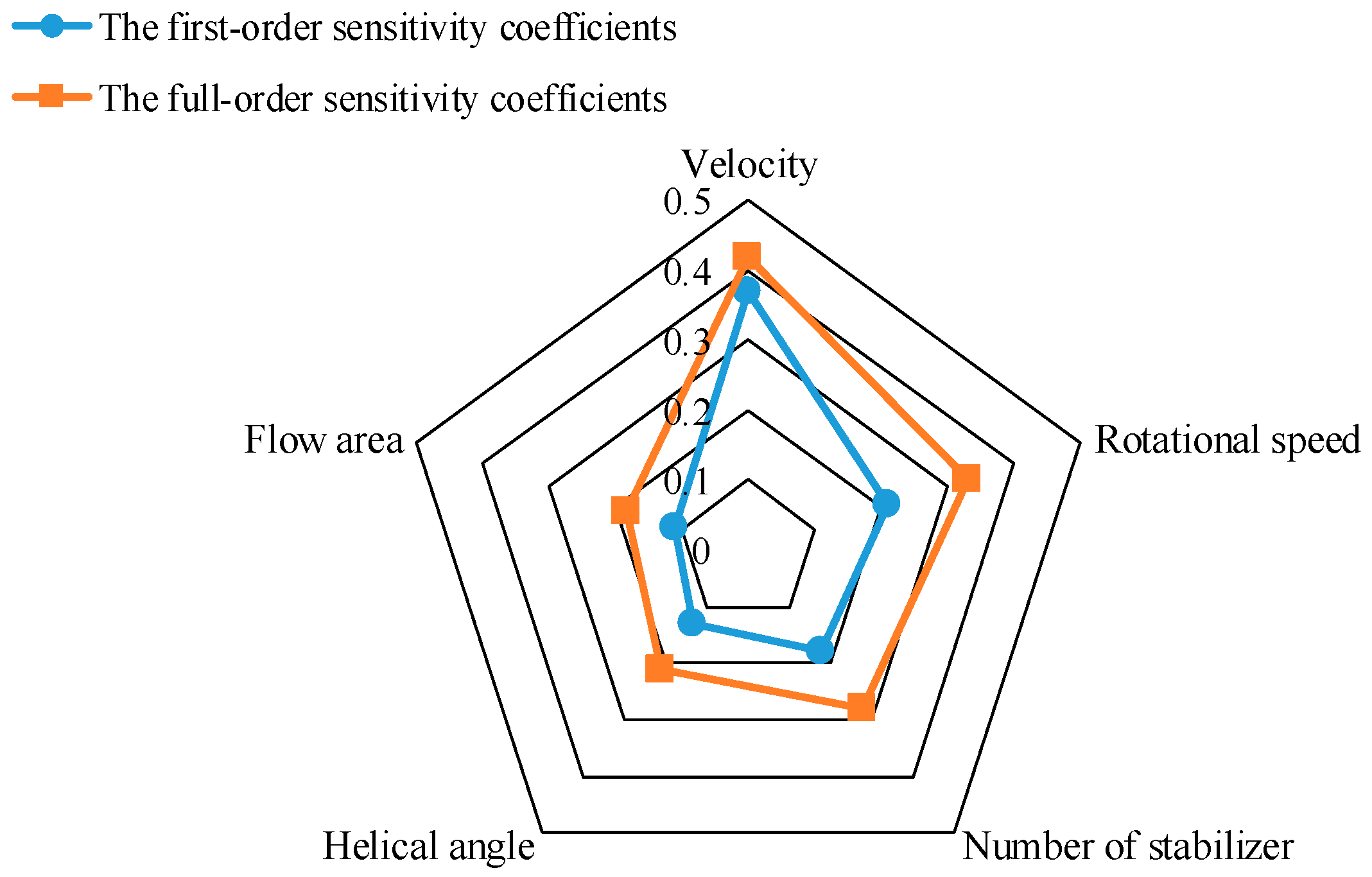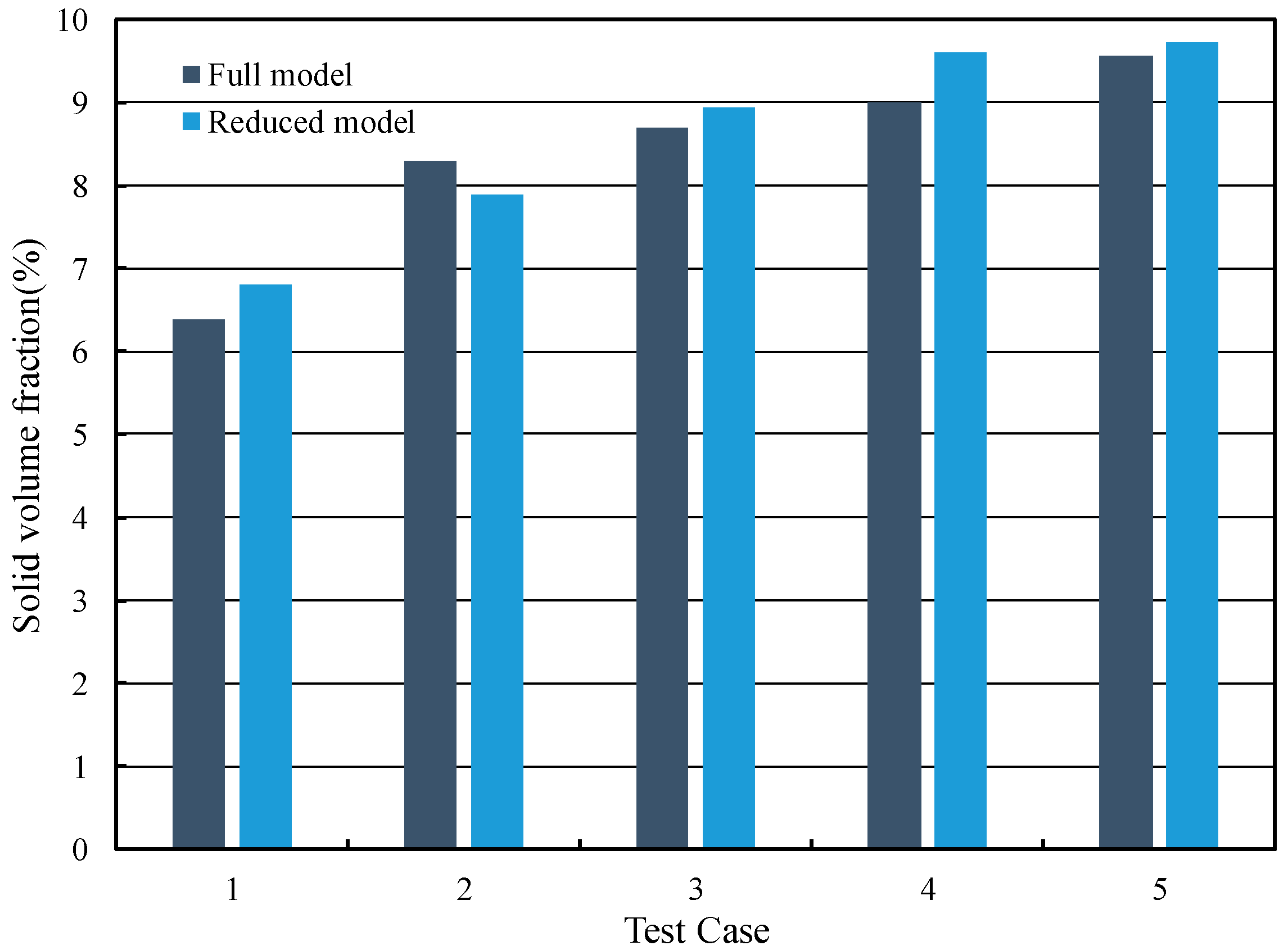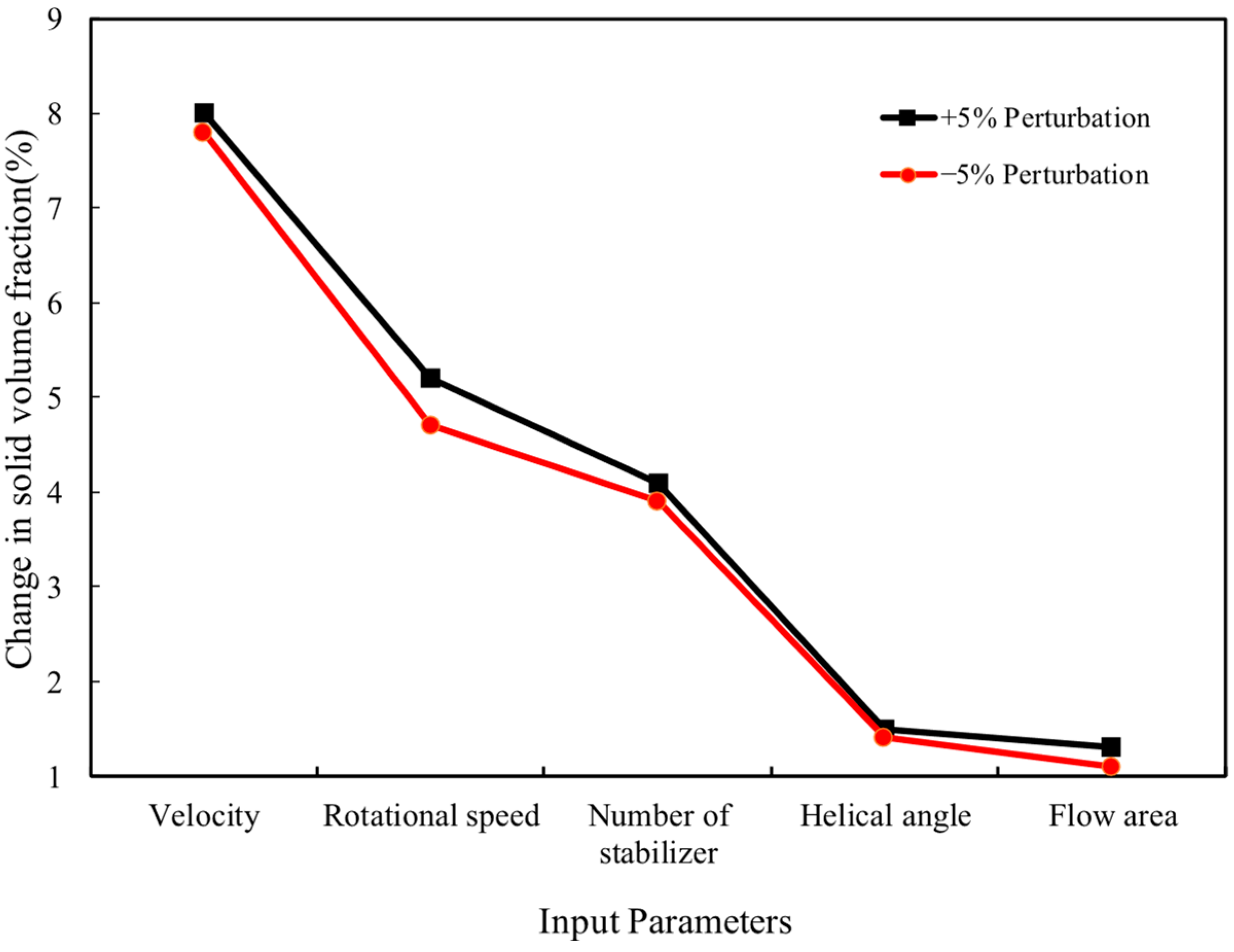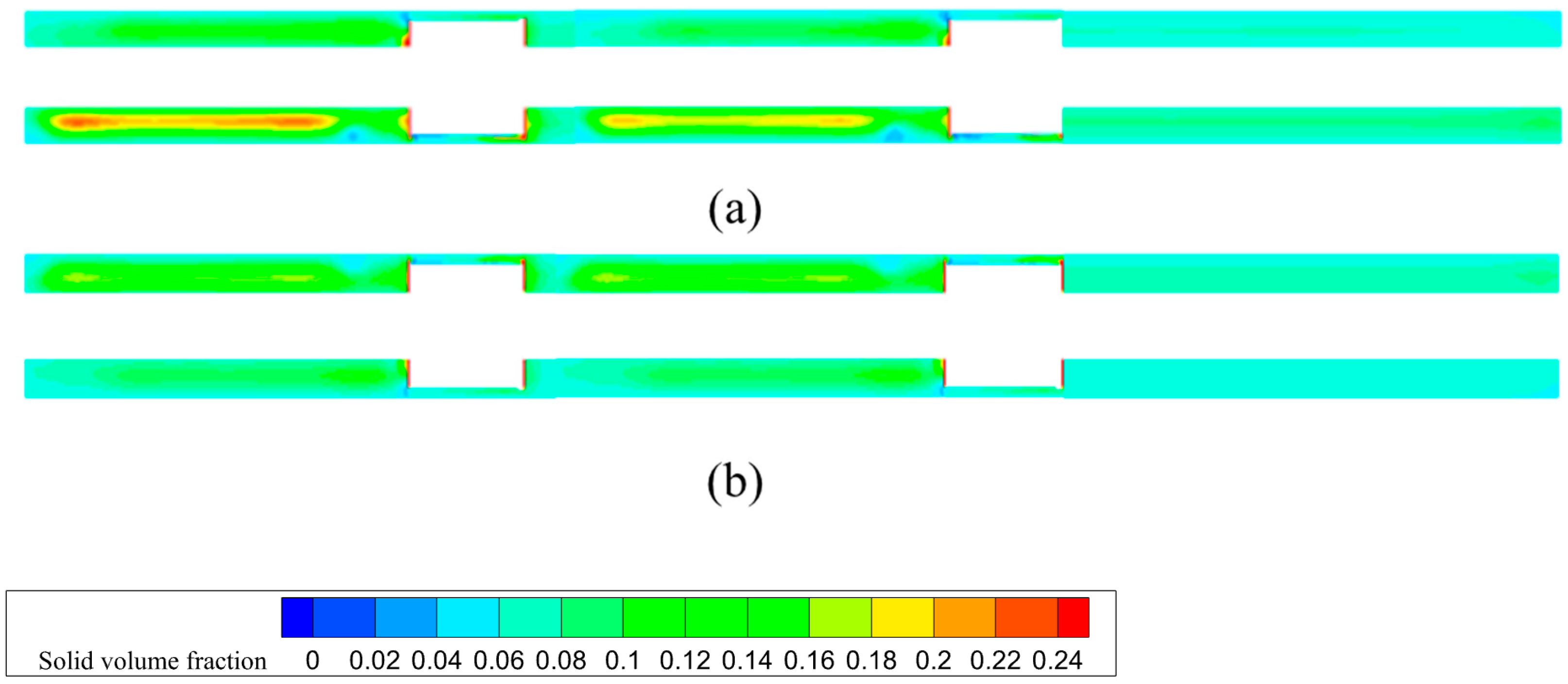Sensitivity analysis is essential for identifying key parameters affecting cuttings transport. The commonly used approaches include the following: (1) Local (one-at-a-time; OAT) sensitivity analysis: This involves perturbing one input parameter at a time while keeping others constant. This method is simple but does not capture interaction effects among variables; (2) Variance-based global sensitivity analysis (e.g., Sobol, FAST) [
23]: This quantifies both the main effects and interaction effects of parameters on the output variance. It is computationally intensive but provides comprehensive sensitivity indices such as first-order, total-order, and interaction coefficients. This method was adopted in this study to evaluate complex nonlinear coupling among multiple drilling parameters; (3) Screening methods (e.g., the Morris method): This is designed for high-dimensional problems with limited computational resources. It provides qualitative rankings of input importance but lacks detailed variance decomposition; (4) Surrogate model-based methods (e.g., Gaussian Process, Polynomial Chaos Expansion): These methods fit a surrogate model and analyze its response surface. While efficient for expensive models, accuracy depends on the surrogate quality. In this study, variance-based global sensitivity analysis (VBGSA) using the Monte Carlo method was employed due to its ability to comprehensively capture both the main effects and interaction effects of key structural and flow parameters. The method is well suited for moderately complex models with limited input dimensionality (five factors in this case) and aligns with the study’s goal of identifying optimal parameter combinations under multi-factor coupling.
4.1. Variance-Based Global Sensitivity Analysis Method
In a k-dimensional unit hypercube
, a square-integrable function is defined as follows:
The function
Y is expanded using High-Dimensional Model Representation (HDMR) as follows:
Equation (22) contains a total of 2
k terms, where
f0 is a constant term,
,
, and so on in the same manner. All the terms in the above decomposition are orthogonal, i.e.,
, and these terms can be calculated by the conditional expectations of
Y, namely
The variance calculation of Equation (22) yields
Dividing both sides by
V(
Y), we obtain
In Equation (25),
Si and
STi are the Sobol sensitivity indices [
25,
26]. Specifically,
Si represents the first-order sensitivity index, which quantifies the contribution of the variation in parameter
Xi to the output variance.
STi denotes the total-order sensitivity index, capturing the contribution of
Xi, including its interactions and those of other variables with the output variance. Therefore, the following relationship holds:
The first-order and full-order sensitivity indices are specifically defined as follows:
In Equation (28), X~I denotes all input variables except Xi.
4.2. Sensitivity Coefficient Calculation
Using the Monte Carlo method [
27] to calculate sensitivity coefficients, first define the sample matrices
A and
B [
28]:
In the above matrices
A and
B,
N represents the number of samples, and
xi(1),
xi(2)…
xi(N) represent the
N sampled values of the parameter
xi. Then
k is the number of input parameters. Matrices
A and
B represent two independent and identically distributed samples, ensuring the statistical validity of the sensitivity index calculations. By replacing one column of matrix
A with the corresponding column from matrix
B to create hybrid matrices, the contribution of each individual input parameter to the model output can be assessed, enabling accurate estimation of both first-order and total-effect sensitivity indices. Next, define the matrix
Ci, which is constructed by taking all the columns from matrix
B except for the
i-th column, which is replaced by the
i-th column from matrix
A:
Based on matrices
A,
B, and
Ci, the corresponding model outputs are obtained as follows:
The first-order sensitivity coefficient
Si and the full-order sensitivity coefficient
STi are obtained as follows:
where
.
4.3. Sensitivity Analysis Results
To quantitatively reveal the influence of each design variable on the cuttings volume fraction, this study employs a variance-based global sensitivity analysis method to calculate both the first-order and total-order sensitivity indices for five parameters: flow velocity, drill pipe rotational speed, number of stabilizers, flow area, and helical angle. The analysis results are presented in
Figure 11.
4.3.1. First-Order Sensitivity Coefficient Analysis
The sensitivity analysis reveals that drilling fluid velocity is the dominant influencing factor, with a first-order sensitivity coefficient of 0.37, indicating its leading role in determining the cuttings volume fraction. Under the condition of a large-diameter vertical well without a cuttings bed, the annular flow field is relatively uniform, and the cuttings transport efficiency mainly depends on the enhancement of axial flow velocity. As the drilling fluid velocity increases, the velocity of the drilling fluid in the annulus rises accordingly, resulting in a significant increase in both shear stress and lift force, which promotes the upward transport of suspended cuttings toward the surface. Additionally, higher drilling fluid velocities intensify particle–fluid interfacial disturbances, facilitating a more uniform spatial redistribution of cuttings within the annular flow. This effectively reduces local zones of high cuttings concentration and improves the distribution profile of the cuttings volume fraction at the outlet section. The simulation results indicate that, with other parameters held constant, variations in the flow velocity alone can cause a substantial reduction in the cuttings volume fraction, confirming its primary influence in hole-cleaning control under the studied conditions.
The drill pipe rotational speed enhances radial and tangential flow components by inducing secondary flows and helical vortices within the annulus, thereby altering the cuttings’ transport trajectories and residence time. Under moderate to high rotational conditions, the cuttings exhibit more complex motion patterns due to intensified flow disturbances, which help to disrupt axial accumulation trends and improve the cuttings transport capacity at the outlet cross-section. The first-order sensitivity coefficient for rotational speed is 0.21, indicating that it is the second most influential factor after the drilling fluid velocity. However, its effect is more susceptible to modulation by the wellbore diameter and stabilizer-induced disturbances, making it less consistent compared with the influence of the drilling fluid velocity.
The number of stabilizers influences the uniformity of the local flow field by altering the distribution of obstructions and the disturbance frequency within the annulus. A reasonable number of stabilizers can induce periodic disturbances in the drilling fluid, thereby promoting the dispersed transport of cuttings. However, excessive stabilizers may introduce additional hydraulic resistance, resulting in local low-velocity recirculation zones that hinder cuttings transport. The first-order sensitivity coefficient is 0.18, indicating a significant independent regulatory effect within an appropriate configuration range.
The helical angle governs the stabilizer’s flow-guiding capability and the intensity of the tangential swirl it induces. A moderate helical angle can generate stable spiral disturbances, facilitating the detachment of cuttings from near-wall regions and their migration into the mainstream flow. Conversely, an excessive helical angle may lead to intensified flow diversion and energy dissipation, thereby reducing the cuttings transport efficiency. The sensitivity coefficient is 0.13, suggesting a moderate independent contribution with a nonlinear response trend.
The flow area determines the acceleration or contraction effects of the drilling fluid as it passes through the stabilizer region. A smaller flow area results in stronger local acceleration, which enhances shear forces and the disturbance frequency, thereby improving cuttings transport dynamics. However, an overly small flow area may induce excessive velocity fluctuations and an increased pressure drop, leading to transient low-velocity zones that weaken the cuttings suspension capacity. The sensitivity coefficient is 0.11, which, although lower than the previous three parameters, still indicates an independent regulatory potential and should be optimized according to operational conditions.
4.3.2. Full-Order Sensitivity Coefficient Analysis
Compared with first-order sensitivity coefficients, full-order sensitivity coefficients are capable of capturing hidden nonlinear responses and coupling enhancement mechanisms among parameters, thus providing a more realistic reflection of the system’s sensitivity under high-dimensional perturbation spaces.
In the full-order analysis, the drilling fluid velocity still exhibits the highest sensitivity, with a full-order sensitivity coefficient of 0.42, which is slightly higher than its first-order sensitivity coefficient of 0.37. This indicates that the influence of this parameter on the cuttings volume fraction is primarily due to its own independent effect while also involving interactions with other factors. In particular, when coupled with the rotational speed, a strengthened cuttings transport channel may form, enhancing flow-field disturbances and improving the particle detachment capability. Additionally, under conditions of larger stabilizer helical angles or smaller flow areas, the driving effect of a high velocity becomes especially pronounced, reinforcing the stability of the cuttings transport path.
The full-order sensitivity coefficient for the rotational speed is significantly higher than its first-order counterpart, indicating that its nonlinear and interaction effects on cuttings transport cannot be ignored. At a certain drilling fluid velocity level, a moderate increase in rotation speed can induce intense secondary swirling structures in the annulus, increasing the frequency of particle agitation and altering the residence-time distribution. When interacting with stabilizer quantity and the helical angle, it can significantly change the local shear force distribution and particle trajectory structure, resulting in a synergistic enhancement effect. Especially under complex annular geometries or frequent stabilizer-induced disturbances, the vorticity generated by rotation plays a key role in particle detachment.
The full-order sensitivity coefficient for the stabilizer quantity also exceeds its first-order value, highlighting its amplified coupling mechanism in regulating cuttings transport. When interacting with the rotation speed and drilling fluid velocity, it can significantly modulate the local flow structure and adjust the scale and distribution of the particle resuspension region. Too few stabilizers lead to insufficient disturbances, while too many cause overlapping interference, obstructing the main flow path. Therefore, its optimal configuration should be synergistically optimized with other variables.
The full-order sensitivity coefficient for the helical angle increases from 0.13 (first-order) to 0.21, revealing a clear nonlinear response trend. This effect is particularly evident in two types of interactions: when coupled with rotation speed, a moderate helical angle can induce enhanced swirling vortex structures, significantly increasing the frequency of cuttings disturbance; when co-regulated with the flow area, it can modify the fluid bypass mode, establish stable cuttings transport paths, and improve the uniformity of particle suspension.
Although the flow area of the stabilizer remains the least sensitive in the full-order analysis, its sensitivity increases from 0.11 (first-order) to 0.18. This suggests that its impact on cuttings transport is mainly realized through synergistic disturbances with the drilling fluid velocity and helical angle. A small area, when coupled with high velocity, can form a high-shear transport zone; a larger area, when combined with a high helical angle, can stabilize vortex structures, enhancing the stability of particle distribution.
The comparative analysis of the first-order and full-order sensitivity coefficients reveals that each influencing factor exhibits a distinct yet significant contribution to the response of the cuttings volume fraction, highlighting the system’s typical nonlinear characteristics and coupling mechanisms under high-dimensional perturbations. Firstly, the drilling fluid velocity consistently serves as the primary dominant factor, holding the highest weight in both first-order sensitivity (direct effect) and full-order sensitivity (including all interaction effects) analyses. This indicates that whether under single-factor perturbation or in joint variation with other parameters, the drilling fluid velocity exerts the most direct and significant impact on the cuttings transport behavior. Fundamentally, this is because the drilling fluid velocity determines the axial velocity and shear intensity in the annular main flow zone, directly controlling the drilling fluid’s cuttings carrying capacity, making it the core driving factor for maintaining borehole cleanliness and operational stability. Secondly, the drill pipe rotational speed and the number of stabilizers form the secondary dominant factors. Their full-order sensitivity coefficients are significantly higher than their first-order values, suggesting that their influence lies not only in their independent contributions but also in their complex nonlinear coupling with other variables (e.g., drilling fluid velocity and stabilizer parameters). For instance, a high rotation speed enhances annular swirling and the flow-disturbance frequency, and in conjunction with a suitable stabilizer arrangement, it can create an intensified cuttings carrying zone. Meanwhile, the number of stabilizers plays a synergistic amplification role by altering local flow-disturbance frequencies and suppressing cuttings sedimentation. Therefore, in engineering optimization, the combined configuration of rotation speed and stabilizer count should be a key focus in achieving structure–flow dynamic matching and coupling. Lastly, although the stabilizer helical angle and the flow area appear as secondary factors in the first-order sensitivity coefficient analysis, their full-order sensitivity coefficients increase significantly, indicating that their impact on cuttings transport primarily stems from interactions with other parameters. Under conditions of a moderate helical angle or a suitably constrained flow area, the reconstruction of local vortex structures and bypass flow channels can effectively enhance the fluid encapsulation and shear capability of cuttings, thereby indirectly improving cuttings transport efficiency. Neglecting their nonlinear coupling characteristics may lead to the formation of cuttings retention zones and reduced cleaning efficiency. Therefore, in parameter design and tuning, these stabilizer parameters should not be optimized in isolation but should, instead, be adjusted collaboratively based on global response and interaction effects.
In conclusion, this study suggests that the drilling fluid velocity should be used as the primary control parameter, rotation speed and the number of stabilizers as cooperative control factors, and stabilizer structural parameters (helical angle and flow area) as responsive adjustment tools. A multi-factor coupled optimization model should be established to achieve efficient and stable cuttings transport and borehole-cleaning performance. This provides theoretical support and an optimization pathway for stabilizer design and drilling fluid parameter matching under large-diameter borehole conditions.
4.3.3. Sensitivity Analysis Model Validation
To ensure the accuracy and credibility of the variance-based sensitivity analysis results derived from the Monte Carlo method, a multi-step verification approach was adopted, incorporating reduced-order modeling [
29], local perturbation testing [
30], and engineering consistency comparison.
Firstly, a reduced-order model was constructed by retaining only the top three parameters exhibiting the highest total-order sensitivity indices—namely, drilling fluid velocity, drill pipe rotational speed, and number of stabilizers—while the remaining two parameters (stabilizer helical angle and flow area) were fixed at their mean values. Then, multiple sets of simulation tests were conducted under different parameter conditions to obtain the solid volume fraction of the simplified model. As shown in
Figure 12, numerical simulations conducted using this simplified model demonstrated that the predicted solid volume fraction deviated by less than 5.9% from that of the full model across the sampled parameter space. This low deviation confirms that the dominant parameters captured by the sensitivity analysis are sufficient to characterize the key behavior of the system.
Secondly, a local perturbation test was conducted to validate the consistency of the sensitivity rankings. Each input parameter was independently perturbed by ±5% around its nominal value while holding the others constant. As shown in
Figure 13, the resulting changes in the solid volume fraction exhibited a trend consistent with the sensitivity coefficients: parameters with high first-order sensitivity coefficients led to substantial output variations, while those with low coefficients induced negligible changes. This further validates the ranking reliability and the local responsiveness of the model.
Lastly, the parameter influence trends identified through the sensitivity analysis were compared with existing field knowledge and published studies. The findings—particularly the dominant role of flow rate and rotational speed [
31,
32]—are consistent with previous conclusions in large-diameter borehole-cleaning research, thus reinforcing the engineering plausibility of the sensitivity-derived results.
This comprehensive verification confirms that the applied sensitivity analysis methodology not only offers robust mathematical insights but also aligns with physical behavior and practical drilling experience.
4.3.4. Interactions Among Parameters
Within the variance-based global sensitivity analysis framework, besides the first-order sensitivity coefficients used to quantify the independent contribution of single factors to the response variable (in this study, the solid volume fraction), the interaction effect terms are also calculated to reveal the coupling relationships among factors and their combined effects on the system output. The specific results are shown in
Figure 14.
The variance-based global sensitivity analysis results reveal pronounced interaction and coupling effects among the five controlling parameters influencing the cuttings volume fraction. The interaction sensitivity indices are as follows: The drill pipe rotational speed exhibits the highest interaction sensitivity index at 0.12, indicating that its synergistic effects with other parameters substantially enhance the cuttings transport efficiency. Particularly, when coupled with an appropriate drilling fluid velocity and stabilizer configuration, complex secondary flow structures and intensified shear zones are generated, significantly improving cuttings suspension and transport. The stabilizer quantity’s interaction sensitivity index is 0.10, signifying that in conjunction with the flow velocity and rotational speed, it effectively extends the perturbation domain and intensifies localized flow disturbances, thereby amplifying the cuttings carrying capacity. Under elevated rotational speeds, multiple stabilizers markedly augment the disturbance region and shear stress distribution, aiding in the mitigation of cuttings deposition. The interaction indices for the stabilizer helical angle and flow area are 0.08 and 0.07, respectively. Despite their comparatively lower first-order effects, these parameters play critical roles in modulating the flow structures responsible for cuttings transport under combined operational conditions. An optimally selected helical angle promotes stable helical shear flows, while a suitably sized bypass area enhances localized cuttings transport efficiency. Their impacts on the solid volume fraction are strongly contingent on their interactive coupling with other parameters. Specifically, under conditions of sufficiently high flow velocity, moderate rotational speed, and appropriate stabilizer count, the helical angle and flow area facilitate the formation of coherent vortex structures and directional shear flows, which enhance particle dispersion and transport. Conversely, isolated adjustment of these parameters may induce uneven flow disturbances or localized low-velocity zones detrimental to cuttings removal. The drilling fluid flow velocity has an interaction sensitivity index of 0.05. Although comparatively low, at high flow velocities, it synergizes with stabilizer disturbances to substantially expand the effective transport zone and suppress cuttings accumulation.
In summary, except for drilling fluid velocity, the remaining parameters exhibit significant nonlinear interaction effects. Notably, the coupling between rotational speed and stabilizer structural parameters exerts a decisive influence on cuttings transport dynamics. Therefore, multi-parameter synergistic optimization strategies are essential for effective design and operational control.
4.4. Optimization Analysis of Cuttings Transport in Large-Diameter Wellbores
Based on the combined results of single-factor analyses and variance-based global sensitivity analyses, it is evident that the cuttings transport process in large-diameter wellbores is significantly influenced by nonlinear coupling among multiple parameters. Complex interactions exist between these factors, and thus the optimal solution for a single parameter cannot directly serve as the optimal design for the entire system. Therefore, when optimizing drilling fluid carrying parameters, full consideration must be given to the synergistic relationships between primary controlling factors and secondary variables to achieve coordinated matching among parameters, thereby improving the cuttings transport efficiency and ensuring wellbore-cleaning stability.
Among all the factors, drilling fluid velocity exhibits the highest first-order sensitivity coefficient and interaction sensitivity, serving as the dominant factor controlling the cuttings carrying efficiency. Higher velocities significantly enhance the fluid’s axial flushing force and vertical lifting force, effectively reducing cuttings deposition. An optimized range of 0.55–0.60 m/s is recommended to ensure the continuous and stable carrying capacity of the drilling fluid.
Drill pipe rotational speed acts as a secondary dominant variable, playing a significant role in enhancing vortex disturbances and promoting cuttings resuspension. It also shows a strong interaction coupling with stabilizer parameters—including the number, helical angle, and flow area. It is suggested to maintain the drill string rotation speed between 85–95 rpm to fully stimulate the vortex-induced carrying capacity and to strengthen fluid shear and cuttings detachment without compromising flow-field stability.
Regarding the number of stabilizers, the analysis indicates that arranging two stabilizers achieves optimal disturbance coverage and cuttings dispersion under the current wellbore geometry. Excessive stabilizers may increase the local flow resistance and pressure drop, negatively affecting the overall flow efficiency; thus, two stabilizers are recommended.
For the stabilizer helical angle, the simulation results show that its influence on cuttings transport mainly manifests through enhanced disturbances and shear intensification. Too small an angle results in insufficient disturbances, while too large an angle can cause flow deflection and local deposition. Therefore, controlling the helical angle within 25–30° is advised to effectively induce swirling flow structures and improve cuttings detachment and transport capacity.
The stabilizer flow area, as a critical geometric parameter affecting fluid passage capacity and disturbance intensity, shows a moderate influence in the interaction analysis. Selecting a flow area of 40–45% balances maintaining the disturbance intensity while avoiding excessive obstruction to the main flow path, facilitating an optimal trade-off between carrying performance and pressure-loss control.
Overall, the recommended optimal parameter combination not only demonstrates excellent cuttings carrying performance at the dominant factor level but also exhibits enhanced system stability and engineering adaptability under multi-factor interaction effects. The simulation results of this combination scheme are shown in
Figure 15. This scheme can provide theoretical support and a design basis for wellbore cleaning control and cuttings transport efficiency improvement in the drilling process of ultra-deep wells and large-diameter wellbores.



